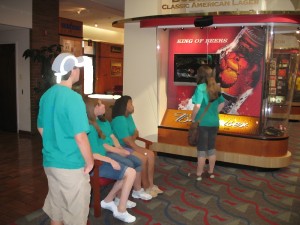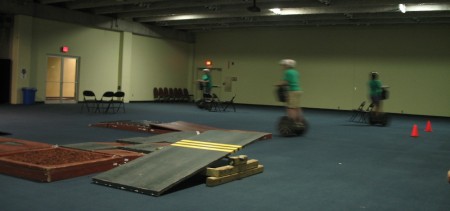The St. Louis Federal Reserve Bank has started a video competition for college students to present economic information. The first competition was to explain opportunity costs.
Scientists tracking oil plumes

As oil continues to leak from the damaged well in the Gulf of Mexico and the surface slick is affecting more and more of the coastline, scientists now using research vessels to track the underwater plumes spreading at depth throughout the gulf.

Satellite imagery from NASA only shows what’s at the surface. To find the underwater plumes, researchers on boats lower instruments on cables that measure the chemistry of the water. Certain chemicals, like colored dissolved organic matter (CDOM) are produced when there is a lot of oil in the water.
Dr. Samantha Joye, from the University of Georgia, is the lead scientist on one such vessel. She started the Gulf Oil Blog where she describes her ongoing work in the gulf and answers readers questions. It is an excellent resource. A great demonstration of science in action, working on a practical problem but using techniques and methods developed over time for answering more abstract questions.

St. Louis overview
I had not particularly wanted to go up into the St. Louis Arch myself, but the students really wanted to and we had a little time to spare after the Science Museum. So I grabbed tickets for the last tram to the top, and I’m glad I did. Looking down on the city and river from above you could, in an almost tactile way, reconcile the geographic elements with the history that we’d talked so much about at Anheuser-Busch.

Standing in line, waiting for the tram to the top, we were treated to a short documentary on the Eads Bridge, the first across the Mississippi in St. Louis. The video stressed the importance of the bridge in allowing the city to become the gateway for westward expansion.
The tram arrived and small rectangular doors opened up to reveal tiny escape pods fit for a spaceship. Five of us squeezed in, fortunately we were all friendly. The distinct possibility of claustrophobia tinged the air. Three minutes 47 seconds later we reached the top. Forty-five degree rain was pouring down outside. The wind was so strong you could, if you held still and waited for it, feel a slight sway in the Arch itself.


Looking east we saw the mighty Mississippi. Not quite so mighty as it is in Memphis, which is downstream of the confluence with the Ohio River, but enormous nonetheless. On the river, huge barges carried freight cars with unknown cargo south toward New Orleans. Just below, an helicopter sat on an helipad barge waiting for an emergency call. Directly across the water, on the east bank, enormous silos with their own docks waited to load barges with grain collected from across the mid-west.
It was still pouring when we left the Arch, and the rain continued on even during dinner. But leaving the restaurant, heading back to the hotel, the setting sun to the west, refracted through raindrops over the river, created one of nature’s own ephemeral monuments. A poignant reminder that forty-five, or even one hundred and forty-five years are but a moment in the deep span of geologic time.
Gardening in small spaces – self-watering containers
The above video, on how to build a self-watering container (this type is also known as a Global Buckets), seems extremely useful for the urban gardener, especially in Memphis where even gardening in the ground is difficult because of the poor, loessic soil. I’ve found container gardening (in cat litter buckets) to be much more effective, even though evaporation is a major issue with our hot summers. So I very much like the idea of self-watering containers.
These containers may also be an excellent complement to our greenhouse, because we can avoid having to water every day. If we got the right containers, or decorated them nicely enough, we might be able to sell these with our vegetables at the end-of-year plant sale.
The related videos on YouTube have a variety of other self-watering container variants. This version, with water jugs and a single large tub, also seems like it might be effective. There are also nice instructional video on how siphons work, as an easier way of watering a series of buckets. The Global Buckets project is a fascinating effort to help reduce malnutrition with simple materials.
Segway lessons
From playing with robots we tried an actual application of robotics. We had the Segways 101 course at the St. Louis Science Center.
The lesson itself was fun, with an entertaining video of people falling off Segways. They also had a little obstacle course to let you try doing all of the things the video told you not to do (but most of it was for the more advanced class).
Afterward, we discussed the fact that this too was robotics and a pretty advanced application at that. We did not talk much about how the Segways were supposed to revolutionize urban transportation but students did recognize the fact that aesthetics were a major impediment to their broader adoption.
The price was a bit steep however, and I’m a little conflicted about if it was worth it.
Lego Mindstorms
I’ve been curious about the Lego Mindstorms robotic systems for a while now, and I had my first chance to try them at the St. Louis Science Center.
The kits come with a micro-controller, a few motors and some sensors. While there are quite a number of ways of assembling these to make robots, the ones at the science center were pre-built except that you could just plug in a bulldozer or sweeper attachment (and a head which was purely decorative). This limited the degrees of freedom to three, which made it easier to program something useful in the hour we had with the robots.
The programming is very basic. There are two sets of instructions, one to control the movement of the robot in general, and one to control its response when the sensor detected a change in the environment. The objective of the science center’s game was to clear off a set of objects from a white rectangle within five minutes.
You could tell the robot to move forward, back or rotate while it’s on the board and to activate its sweeper or shovel. So a full program could have just five elements; general: lower shovel –> move forward –> rotate; sensor: move backward –> rotate. With these strict limitations, the programming interface is also very simple; you plug in blocks with each instruction in the series for either the general movement or the sensor reaction. With all this simplification, I’m not sure just how much the students learned about programming from our short session.
The full kit from Lego offers more freedom to design robots and thus more flexibility with the programming interface so with a little thought it could be easily integrated into the curriculum. At about $300 each the system is a bit pricy, we’d probably need to get one kit for each small group of 3-4 kids. They would probably be worth it however if we used them more than just once.
I’ve been playing with the Basic Stamp micro-controller for a while, and while it offers almost infinite flexibility, making it more useful for practical applications, it does not provide the immediate gratification of the robots, and the ease of assembly to make it the better tool for introducing robotics to middle schoolers. I still, however, tend to favor practical applications, so perhaps I can persuade a student to do an advanced project to build an automatic window for the greenhouse.
The session at the Science Center was worthwhile. All of the students seemed to enjoy it. It provided a nice integration of the mechanics and electronics we’ve been learning about all year, and a glimpse of where technology is taking us in the future.
Anheuser-Busch and the industrial revolution

Why take a group of middle schoolers on a tour of the Anheuser-Busch factory? After all, no one will be trying any samples and the main point of the museum and the tour itself is to make people feel good about the company and buy more of its products. Which would be beer.

The answer is that the history of the company ties directly into the history of the industrial revolution in the U.S.. Its large scale industrial process was made possible by the serendipitous German immigration into St. Louis in the late 1800’s. Just then the expansion of grain farming in the mid-west and the railroads could supply the raw materials for beer on a massive scale. New assembly lines and automation could efficiently process these inputs, resulting in large scale production. Successes bred new inventions, with the company retaining the services of Rudolph Diesel to introduce his engine to the U.S..

The survival of the company during prohibition (1920-1933) was another point of interest. Anheuser-Busch survived by diversifying from its core business, making non-alcoholic drinks and selling baker’s yeast among other things. At the end of prohibition, Anheuser-Busch was the only large brewer left in the city St. Louis.

We also saw a bit of chemistry during the tour. The breakdown of complex starches into sugars as part of the fermentation process is a basic example of organic chemistry in action (polymers –> monomers). Light beer, for example, is kept in the tanks longer so that more of the starches are broken down into simple sugars. There were even a couple of big models of barley grains and hops buds showing their parts, that tie in to our life-science lessons next year.

Even the surfeit of advertising could be used to advantage; the first thing inside the door of the museum is a television playing Anheuser-Busch’s most successful commercials. We’ve been discussing propaganda all year, so the students were somewhat inoculated to the barrage of feel-good messages, and we specifically discussed this in our post-tour group meeting.
Our tour guides were great. Informative, friendly and willing to answer questions, I particularly appreciated that they joined us in our group discussion after the tour and answered the questions that came up as best they could.
This tour exceeded my expectations.
Scrap metal playground
The St. Louis City Museum is an excellent place for the kinestetic. They assembled scrap metal from all around the city, including coils of metal, wire fencing, steel-plate slides and airplane fuselages, and gave it to artists to produce an exceptional, innovative playground.
Wire tubes extended across the air, two-three-four stories high, barely wide enough to crawl through. If you’re claustrophobic and afraid of heights you would think it would be a nightmare, but the wire mesh is sturdy enough that you feel secure, while being open enough to so you don’t feel closed in.
There’s other stuff inside the museum, the staff says it’s always under construction, including a warehouse of gargoyles and building facing saved from demolition, however it’s the outside that’s most remarkable.









